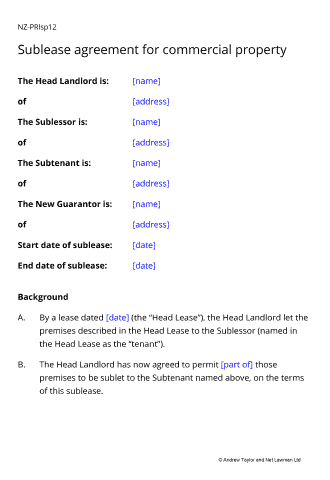

This sublease includes optional provisions that give the head landlord additional rights when dealing with the subtenant. It can be used to sublet part of or the whole of any commercial property, including offices, shops, industrial units such as factories, warehouses and workshops, and land. Features: new guarantor; release of old guarantor; break provision; rent review options; drawn for the property owner or experienced property professionals.
Compliant with the latest law Document propertiesMicrosoft Word DOCX Apple Pages RTF
Backed by our watertight guaranteeIf the document isn’t right for your circumstances for any reason, just tell us and we’ll refund you in full immediately.
Written in plain EnglishWe avoid legal terminology unless necessary. Plain English makes our documents easy to understand, easy to edit and more likely to be accepted.
Guidance notes includedYou don’t need legal knowledge to use our documents. We explain what to edit and how in the guidance notes included at the end of the document.
Support from our legal teamEmail us with questions about editing your document. Use our Lawyer Assist service if you’d like our legal team to check your document will do as you intend.
Up to date with the latest lawOur documents comply with the latest relevant law. Our lawyers regularly review how new law affects each document in our library.
Sometimes a landlord may allow subletting, but require further restrictions or obligations on the subtenant. The most useful of these is the ability to "bypass" the sublessor and deal directly with the subtenant if necessary. By setting these terms, the head landlord can proceed without the necessity of establishing the default of the sublessor in court.
When someone wants to litigate, nothing can be certain. But the sublessor cannot sign to this sublease then later deny these rights of the head landlord.
Your sublease can follow or deviate from the terms of the original lease as much as you like. You could carve out the sublease from the head lease with the same terms, or alternatively, specify different terms and impose further obligations on the new tenant.
Typically, this document would be used by the head landlord (perhaps in conjunction with the original tenant) to sublet:
If you are subletting only part of the property you will need to look afresh at how responsibilities such as service provision, access, insurance and so on are split between the head landlord, you the sublessor and your subtenants. We provide for many different possible options. This is a very flexible document.
The sublessor should first check the original lease. Subletting may be allowed and if so, the permission is likely to be subject to specific conditions. If not allowed, it may be possible, with the landlord's consent, incorporate terms in favour of the head landlord in return for allowing subletting.
Plain English is used throughout except where it is necessary to use legal terms common in land law.
The key features of this template can be summarised as:
This sublease is one of a collection of commercial lease templates designed for use by property professionals: experienced landlords, solicitors and surveyors. Accordingly, the provisions are very thorough.
The document includes the (optional) provision to release the old guarantor from his obligations as the new guarantor takes over.
Commercial leases in New Zealand are governed by the Property Law Act 2007. There is no legal requirement that lease must be registered. However, the parties have the option of protecting their interests by registering the lease. A sublease carved out of a registered head lease should itself be registered.
We offer two subleases. This version has been drawn for circumstances where the head landlord requires deeper and more detailed involvement in the relationship between himself and the new subtenant. If you don't need these provisions, you may be interested to look at: Underlease agreement for commercial property.
Note that this document is not suitable for subletting residential tenancy agreements. In those situations, we recommend cancelling the original and using a new tenancy agreement to let the property to the new tenants.
The template is comprehensive at 27 pages excluding guidance notes. Contents include: